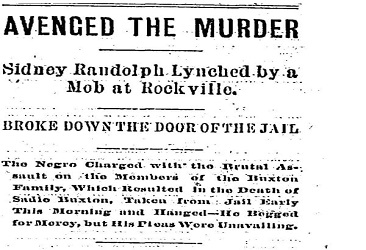 Feature – ‘A shameful affair’: The last man lynched in Montgomery County, Md. Around 1 a.m., a lynch mob overpowered the county jailer and whisked away the doomed man, an itinerant worker from Georgia. He had been accused in the ax murder of 7-year old Sadie Buxton, a white girl, as she slept at the family farm in Gaithersburg. Sadie’s 16-year old sister and parents were also wounded in the attack but survived. Randolph maintained his innocence to the end. No arrests were ever made in the lynching. In Randolph’s case, the coroner’s jury concluded that he had been lynched “by hands unknown.” Read more
Feature – ‘A shameful affair’: The last man lynched in Montgomery County, Md. Around 1 a.m., a lynch mob overpowered the county jailer and whisked away the doomed man, an itinerant worker from Georgia. He had been accused in the ax murder of 7-year old Sadie Buxton, a white girl, as she slept at the family farm in Gaithersburg. Sadie’s 16-year old sister and parents were also wounded in the attack but survived. Randolph maintained his innocence to the end. No arrests were ever made in the lynching. In Randolph’s case, the coroner’s jury concluded that he had been lynched “by hands unknown.” Read more
 National Prison Strike Begins: Prisoners in 17 States Demand End to “Slave Labor” Behind Bars. This is a video made by the Incarcerated Workers Organizing Committee with the nonprofit Planting Justice, explaining why prisoners are striking. Watch the video here. Also see, Why Prisoners Are Going On Strike Today
National Prison Strike Begins: Prisoners in 17 States Demand End to “Slave Labor” Behind Bars. This is a video made by the Incarcerated Workers Organizing Committee with the nonprofit Planting Justice, explaining why prisoners are striking. Watch the video here. Also see, Why Prisoners Are Going On Strike Today
 In Alabama, Challenging Hidden Racial Discrimination. A federal appeals court has allowed fast-food workers to contest a state law blocking the city of Birmingham from raising its minimum wage. The Birmingham plaintiffs argued that the lawmakers discriminated against residents of the city, which is 74 percent black, with 32 percent of the population living below the federal poverty line. Read more
In Alabama, Challenging Hidden Racial Discrimination. A federal appeals court has allowed fast-food workers to contest a state law blocking the city of Birmingham from raising its minimum wage. The Birmingham plaintiffs argued that the lawmakers discriminated against residents of the city, which is 74 percent black, with 32 percent of the population living below the federal poverty line. Read more
 Asian-Americans Need More Movies, Even Mediocre Ones. A mediocre movie about Asian-Americans will not kill careers or be seen as a failure of and for Asian-Americans, just as a mediocre movie by and about white people says nothing about white people. For Asian-Americans, if “Crazy Rich Asians” succeeds, we all do; if it fails, we all do. This is what it means to live in an economy of narrative scarcity. Read more
Asian-Americans Need More Movies, Even Mediocre Ones. A mediocre movie about Asian-Americans will not kill careers or be seen as a failure of and for Asian-Americans, just as a mediocre movie by and about white people says nothing about white people. For Asian-Americans, if “Crazy Rich Asians” succeeds, we all do; if it fails, we all do. This is what it means to live in an economy of narrative scarcity. Read more
 Why Are Black And Latino Kids More Likely To Die Of Certain Cancers? For epidemiologist Rebecca Kehm, the answer could lie not in a test tube or even a patient’s race, but in their place in society. In a paper published Monday in the journal Cancer, Kehm and her coauthors pinpoint socioeconomic status as a factor in childhood cancer survival. Read more
Why Are Black And Latino Kids More Likely To Die Of Certain Cancers? For epidemiologist Rebecca Kehm, the answer could lie not in a test tube or even a patient’s race, but in their place in society. In a paper published Monday in the journal Cancer, Kehm and her coauthors pinpoint socioeconomic status as a factor in childhood cancer survival. Read more
 Before Trump, segregationist George Wallace tapped into racial fears. He also used tactics that his daughter and some historians see echoes of in President Donald Trump’s approach to campaigning. Like Trump, Wallace boasted of his crowd sizes; complained of “rigged polls” and accused the media of treating him unfairly, all while working to ensure the spotlight stayed on him. In his campaign, Wallace dropped some of the more explicitly racist and segregationist language he used as governor of Alabama. But the ideas were the same. Read more
Before Trump, segregationist George Wallace tapped into racial fears. He also used tactics that his daughter and some historians see echoes of in President Donald Trump’s approach to campaigning. Like Trump, Wallace boasted of his crowd sizes; complained of “rigged polls” and accused the media of treating him unfairly, all while working to ensure the spotlight stayed on him. In his campaign, Wallace dropped some of the more explicitly racist and segregationist language he used as governor of Alabama. But the ideas were the same. Read more
 How broad is support for white nationalism? Last week’s Unite the Right flop isn’t the whole story. Don’t be fooled by the pathetic turnout in D.C. or the media mockery. It remains true that white supremacy is both resurgent and ascendant in America. Both public policy and day-to-day norms are being reoriented by a form of backlash politics that emphasizes an explicitly white-supremacist agenda and blends Christian nationalism, racial authoritarianism, plutocracy, sexism and nativism. Read more
How broad is support for white nationalism? Last week’s Unite the Right flop isn’t the whole story. Don’t be fooled by the pathetic turnout in D.C. or the media mockery. It remains true that white supremacy is both resurgent and ascendant in America. Both public policy and day-to-day norms are being reoriented by a form of backlash politics that emphasizes an explicitly white-supremacist agenda and blends Christian nationalism, racial authoritarianism, plutocracy, sexism and nativism. Read more
 ‘Silent Sam’: A racist Jim Crow-era speech inspired UNC students to topple a Confederate monument on campus. In 1913, Julian Carr, a prominent industrialist and supporter of the Ku Klux Klan, was invited to speak at the unveiling of a statue of a Confederate soldier on the campus of the University of North Carolina at Chapel Hill. Carr’s lengthy address made clear the symbolism of the statue. First, he credited Confederate soldiers with saving “the very life of the Anglo Saxon race in the South,” adding, “to-day, as a consequence the purest strain of the Anglo Saxon is to be found in the 13 Southern States — Praise God.” Read more
‘Silent Sam’: A racist Jim Crow-era speech inspired UNC students to topple a Confederate monument on campus. In 1913, Julian Carr, a prominent industrialist and supporter of the Ku Klux Klan, was invited to speak at the unveiling of a statue of a Confederate soldier on the campus of the University of North Carolina at Chapel Hill. Carr’s lengthy address made clear the symbolism of the statue. First, he credited Confederate soldiers with saving “the very life of the Anglo Saxon race in the South,” adding, “to-day, as a consequence the purest strain of the Anglo Saxon is to be found in the 13 Southern States — Praise God.” Read more
 There Is More to Stacey Abrams Than Meets Partisan Eyes. In the six years when Ms. Abrams led the Democrats in the State House, though, she proved to be a much more complex political character than the portraits now painted by either her most outspoken adversaries or her most fervent fans. Rising from obscurity in 2011 to helm a diminished and beleaguered caucus, Ms. Abrams, a Yale Law School graduate, showed a penchant both for standing on liberal principle and for negotiating with her opponents. Read more
There Is More to Stacey Abrams Than Meets Partisan Eyes. In the six years when Ms. Abrams led the Democrats in the State House, though, she proved to be a much more complex political character than the portraits now painted by either her most outspoken adversaries or her most fervent fans. Rising from obscurity in 2011 to helm a diminished and beleaguered caucus, Ms. Abrams, a Yale Law School graduate, showed a penchant both for standing on liberal principle and for negotiating with her opponents. Read more
 Silicon Valley is leaving women of color behind. Efforts to increase diversity in technology have largely been focused on race or gender, but not both, overlooking obstacles unique to women of color. A new report by the Kapor Center and the Center for Gender Equity in Science and Technology at Arizona State University highlights three of them: Women of color get fewer computer science degrees, end up significantly underrepresented in the tech industry – particularly in leadership roles – and receive less funding from venture capitalists. Read more
Silicon Valley is leaving women of color behind. Efforts to increase diversity in technology have largely been focused on race or gender, but not both, overlooking obstacles unique to women of color. A new report by the Kapor Center and the Center for Gender Equity in Science and Technology at Arizona State University highlights three of them: Women of color get fewer computer science degrees, end up significantly underrepresented in the tech industry – particularly in leadership roles – and receive less funding from venture capitalists. Read more
Visit our home page for more articles, and at the top of this page register your email to receive notification of Race Inquiry Digest updates. Click here for earlier Digests.